It’s been twenty years since the release of WCW vs nWo: World Tour for the Nintendo 64, and I’ve gone and let the anniversary happen in November without much celebration about it! At this point, today is literally the last moment I could post something on it while still being able to celebrate its birthday.
World Tour was the start of something special for the Nintendo 64 console. It not only was the first WCW title for a Nintendo system since 1994’s release of WCW: The Main Event for the Game Boy WCW Superbrawl for the SNES, but it hit stores at a time when World Championship Wrestling was on top of the professional wrestling world. The television success of WCW Monday Nitro and introduction of the villainous New World Order stable helped push the company ahead of the World Wrestling Federation in terms of overall popularity. From 1997, things would only get bigger and better for the industry as a whole, but this was the period when wrestling starting to break into the mainstream consciousness in a way that hadn’t been seen before. In a way, maybe WCW vs nWo: World Tour could have been a factor in WCW and the WWF becoming pop-culture behemoths during the late 90’s.
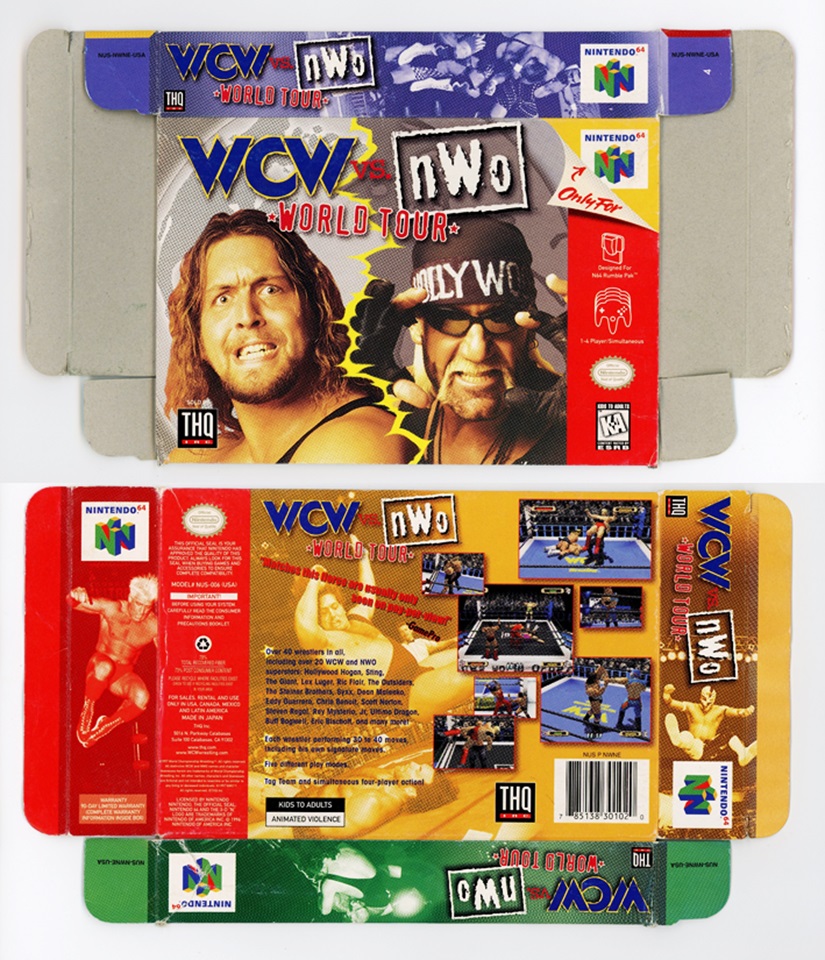 WCW vs nWo: World Tour ended up getting released the final week of November 1997. World Championship Wrestling had been riding a wave of rising popularity throughout the year, so the timing was perfect for THQ’s game to hit store shelves right before Christmas. By then, Nintendo 64 owners had nothing available to help get them their wrestling fix but then again, wrestling games around then weren’t exactly that great to begin with. I doubt anyone could have predicted exactly what World Tour would end up meaning for the still growing N64 platform as it ended up becoming the starting point for many other successful titles.
WCW vs nWo: World Tour ended up getting released the final week of November 1997. World Championship Wrestling had been riding a wave of rising popularity throughout the year, so the timing was perfect for THQ’s game to hit store shelves right before Christmas. By then, Nintendo 64 owners had nothing available to help get them their wrestling fix but then again, wrestling games around then weren’t exactly that great to begin with. I doubt anyone could have predicted exactly what World Tour would end up meaning for the still growing N64 platform as it ended up becoming the starting point for many other successful titles.
The roots of WCW vs nWo were found in every subsequent wrestling title developed by Asmik Ace Entertainment and AKI Corporation, all exclusive to the Nintendo console. You could argue that for the time every single one of these releases hit stores, it legitimately was THE GREATEST WRESTLING GAME EVER CREATED. No hyperbole here, there simply was no real competition in America when it came to wrestling video games which means that Nintendo fans were just ridiculously #blessed for a while.
The Big Show (The Giant): “I did kinda get one over on [WCW] though. Yeah, I can tell it. It’s been ten years now. The company’s dead, they can’t do nothing to me now.
When that first video game came out, I was on the cover of the video game, [WCW vs nWo: World Tour]. I went and did some shoots with the ping-pong balls on my elbows, and all that stuff… motion capture stuff, little bit for some of the stuff I was doing for the chokeslam and whatnot. A few months go by and whenever the game comes out, I get a check from the video game company that was TWICE what I made in a year for WCW. I took it out and cashed it and put it in four different banks. I opened up four different bank accounts and spread it all over the place, I didn’t know what to do with it. I just knew that this was a whole lot of money, and I’m not giving it up.
[WCW’s] attorney Gary Jester called me, “Umm… they kinda made a mistake, they sent you the…”, I said, “Nah, bud. That money’s already gone. I had a debt that I had to pay.”
I just lied my ass off. “You can check my main…”, I gave him my number and my main checking account that had nothing in it.
He didn’t know I had it stashed everywhere else. “So, this is–I mean, it’s gone. I don’t have it anymore, you know. I’m sorry.”
The next time I did the video game thing, there were three lawyers and two accountants and about eight feet of paperwork.” – Stone Cold Podcast [2016]
Asmik/AKI didn’t just get lucky on their first go-round with wrestling titles as AKI Corporation’s founder came from a team that worked on another hugely successful wrestling video game series. Shuji Yoshida had spent years with Human Entertainment, a company known for their Fire Pro Wrestling series over in Japan. After leaving Human to form his own company, Yoshida headed a team that created a 3D wrestling engine that took inspiration from the wrestling titles he helped craft from his former company. Under the name The Man Breeze, the team released WCW vs The World for the PlayStation here in America.
The gameplay featured in WCW vs The World was a rough version of what ended up in every one of AKI’s Nintendo 64 games. Not only were the character models and presentation similar to what would show up in World Tour but even some of the wrestlers’ move animations were exactly the same. AKI refined and retooled their system a bit and ended up with a more polished wrestling title with their first release on the Nintendo platform.
WCW vs nWo: World Tour had so many great things going for it. The fluidity of the wrestling animations, the simplified pick-up-and-go gameplay, the absolute feeling of impact certain strikes had; this was an instant hit in our household even though it was filled with people who actually didn’t care about WCW or even wrestling at all.
Seriously. I rented this on a whim while slightly panicking inside Blockbuster Video at age thirteen. While out running errands, I begged my Mom to make a quick pit stop at the video store. She ended up staying in the car as I rushed through the game aisle to pick something, anything with multiplayer for the Nintendo 64. I grabbed World Tour and Wheel of Fortune in a hurry as to not try my Mom’s patience. World Championship Wrestling and professional wrestling was something that mostly existed for me through video games as we didn’t have cable television growing up in the country. I already had run-ins with characters like Sting and Randy Savage through previous WCW and WWF titles and the few VHS tapes I’d rented over the years, but I wasn’t a weekly follower by any means. This game changed all that, and I’m sure I’m not alone when it comes to WCW fandom origin stories from people my age.
Michael Donahoe: “[WCW vs nWo: World Tour] kinda kickstarted the wrestling game phenomenon, I would say. Cause after that game came out, wrestling games went from being something that was a little niche–like, all the [wrestling] games we talked about previously… yeah, we played them. They were ok, but they weren’t really something that people really gravitated towards. But with the boom of the nWo era, with the Monday Night Wars and with this particular game, this is the point where publishers and developers really were like, ‘Holy shit! Wrestling games… they can actually be something.'” – Retronauts #12: ‘Wrestlenauts’ [December 16th, 2013]
It’s something that’s pretty impossible to track, but I don’t find it outside the realm of possibility that the popularity of WCW vs nWo: World Tour led to more people becoming converted into wrestling fans. That definitely was the case for myself as I was switching channels on day back in ’98 but paused on TBS as soon as I came upon WCW Thunder. Scott Hall doing his typical survey shtick in the middle of the ring, but it was in that moment that I realized that the rough-looking Scott Hall featured in World Tour was actually Razor Ramon from WWF WrestleMania: The Arcade Game. From then, I realized how stacked WCW’s roster was and more names/faces from the game would eventually click in similar manner for me as the weeks went on. I was a full-fledged fan of World Championship Wrestling at that point and would start down the road of buying the monthly magazines and PPVs up to the company’s demise in 2001.
During this early time of my wrestling fandom, I’d find my friends also falling for World Championship Wrestling as well. The N64’s console’s setup of allowing four player controllers to plug-in immediately out of the box without an additional multi-tap accessory was such an understated move of brilliance on Nintendo’s part. I didn’t know much about wrestling, my friends didn’t seem to care at all about wrestling but World Tour was just fantastic late-night multiplayer bliss. It didn’t take long for us to understand the oddball rules laid out in this fictional sport or to pickup on the gameplay mechanics at all. AKI used a fighting system that was timing, context and pressure sensitive, mechanics that obviously drew its influence from Human Entertainment’s Fire Pro Wrestling games.
Tap the button for light attacks, hold the button for stronger ones. Strike reversals and grapple counters were all timing based, triggered by hitting the correct shoulder button at the right moment. On-screen SPIRIT meters took the place of a traditional fighting game healthbar which allowed matches to have an actual ebb and flow throughout it. If you hit a hot streak with a successful chain of uninterrupted attacks, taunts and high-risk maneuvers, your SPIRIT meter would run red-hot allowing you a small window of time where you could pull off your character’s signature finishing maneuver. Likewise, if you’re on the other end of your opponents unrelenting attacks, your SPIRIT meter would burn down to a putrid purple color, leaving you more susceptible to submissions and pinfalls. Matches would never seem to be unfair or one-sided as the meter would automatically reset itself after a short period of time in both its highest and lowest points, meaning an eventual comeback could always take place if you or your opponent was experienced enough.
The in-game sound effect for your strikes also helped convey how impactful these wrestlers’ attacks were. Using Hollywood Hogan’s running strike maneuver would result in a satisfyingly sharp sound, but if you timed the move just right, you could get a deeper, grosser CLUNNK! reminiscent of a sledgehammer caving in a watermelon. In certain instances, this could lead to an automatic T.K.O. which gave a much more ghoulishly gratifying victory. It was harmless fun to see these humanish blockmen brutalize each other with sickening suplexes and running lariats. Watching a submission hold get cinched in, pushed to the point of breaking, and getting rewarded with a bone-breaking SNAP! before your automatic victory animation; so, so good!
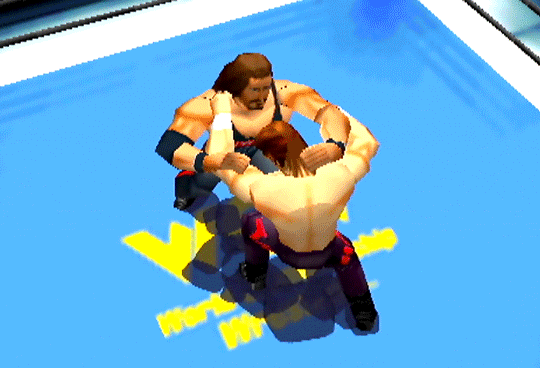
When your Kevin Nash hit his jackknife powerbomb finisher and the opponent struggled to regain consciousness, it was an incredible moment to behold especially if that laid out rival belonged to an actual human being there in room with you. If something similar happened on live television, it’d be a terrible and tragic event… but this was a video game. Making your character fly out of the ring at top speed for a springboard plancha was always exciting, even the times when you hilariously overshot or just flatout missed your opponent. If your strike was deadly enough, sometimes your opponent would also drop down on the mat before feeling their face in a panic, realizing that they had become a bloody mess (a first for wrestling games in America?).
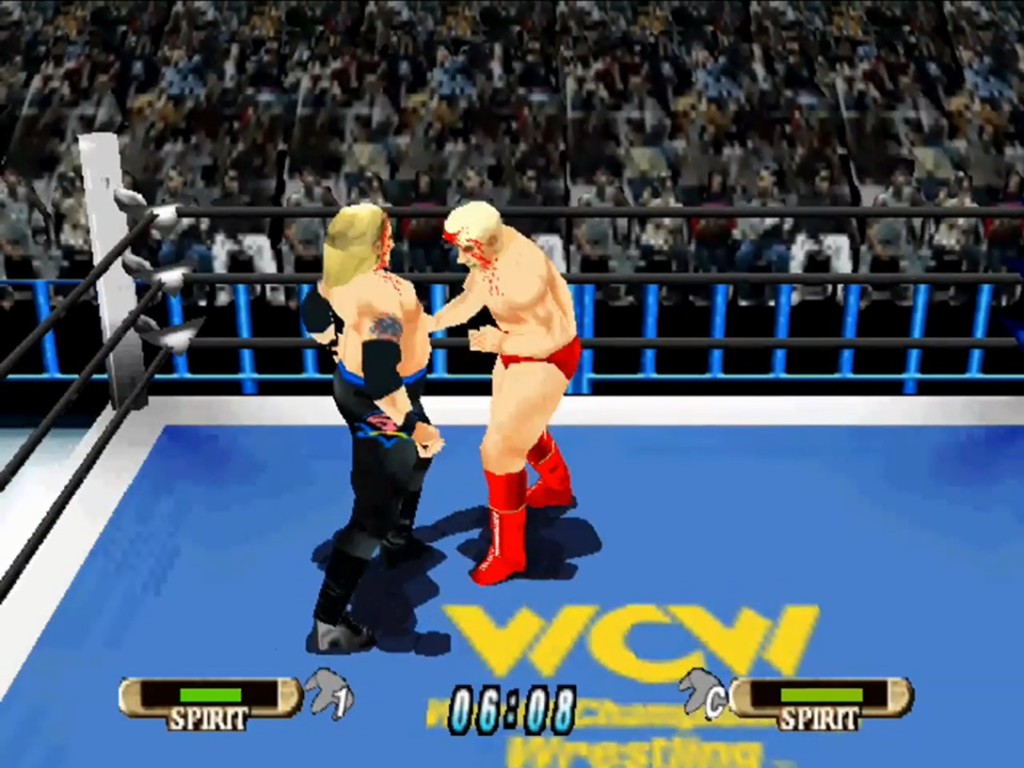
When it comes to wrestling video games, WCW vs nWo: World Tour could also have one of the best rosters ever (even if I didn’t realize it back in 1997). There are several wrestling leagues included to choose from with only twenty-three out of the forty-two characters being actual WCW/nWo wrestlers. The rest of the fighters are all fictional, hailing from made-up promotions BUT each fabricated grapplers’ moveset, attire and style were based on legitimate Japanese wrestlers. As someone who was still putting together that Kevin Nash and Diesel were one in the same, this fact went completely over my head when I was first playing it. Going through some preview shots recently that showcase an early build of World Tour would even suggest that AKI had planned on keeping the Japanese wrestlers in the game without changing their looks or names at all. I assume that copyright issues must’ve got in the way here. Maybe someone at THQ decided it’d be safer to go the route they did, but early pics showcase Masahiro Chono, Kensuke Sasaki, Great Sasuke, Gran Naniwa and others being available to select as playable characters.
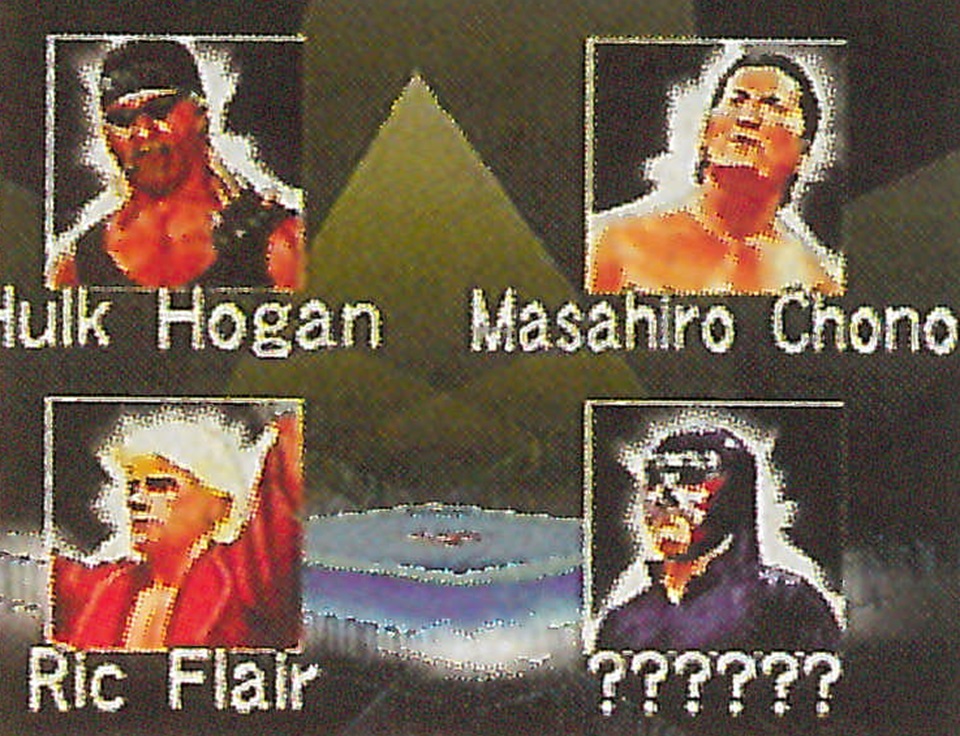
Weirdly enough, Masahiro Chono ended up not being included in the final release despite actually having a presence in WCW as a member of nWo Japan. For whatever reason, he was cut out of the game while others were retooled before the title hit shelves.
World Championship Wrestling (WCW)
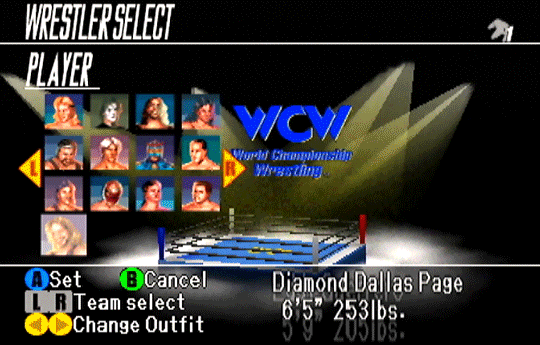
- Lex Luger
- Sting
- The Giant
- Scott Steiner
- Rick Steiner
- Ric Flair
- Ultimo Dragon
- Dean Malenko
- Eddy Guerrero
- Rey Mysterio, Jr.
- Chris Benoit
- Steven Regal
- Diamond Dallas Page (unlockable character)
New World Order (nWo)
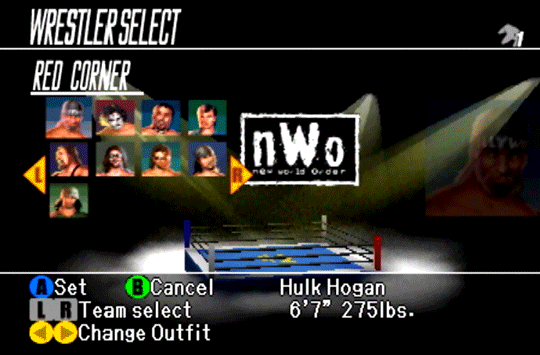
- Hollywood Hogan
- “Sting”
- Buff Bagwell
- Eric Bischoff
- Scott Norton
- Kevin Nash
- Scott Hall
- Syxx
- “Macho Man” Randy Savage (unlockable character)
Dead or Alive Wrestling (Based on Frontier Martial Arts Wrestling)
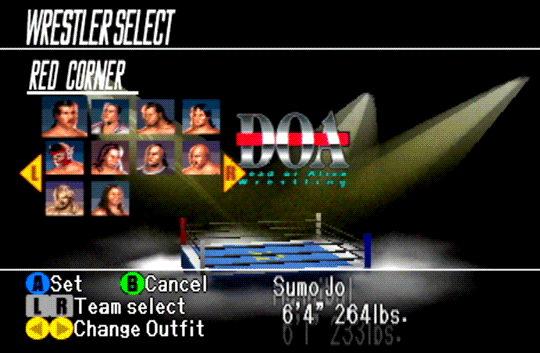
- Sumo Jo (Genichiro Tenryu)
- Kim Chee (Koji Kitao)
- Blackheart (Tarzan Goto)
- Pucheta (Atsushi Onita)
- Hannibal (Hayabusa) (!!)
- Powder Keg (Terry “Bam Bam” Gordy) (!)
- Dim Sum (Gedo)
- Saladin (Abdullah the Butcher)
- Ali Baba (The Sheik)
- Wrath (unlockable character)
Independent Union (Based on Michinoku Pro Wrestling)
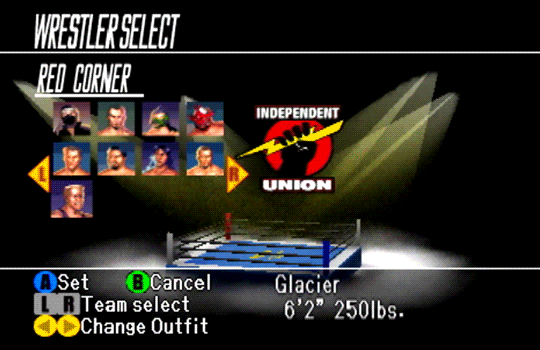
- Black Ninja (The Great Sasuke)
- Shaolin (Jinsei Shinzaki)
- The Unknown (Super Delfin)
- The Claw (Gran Naniwa)
- Black Belt (Taka Michinoku)
- Paco Loco (Dick Togo)
- Shaman (Wellington Wilkins Jr.)
- Master Fuji (Gran Hamada)
- Glacier (unlockable character)
Whole World Wrestling (Secret League)
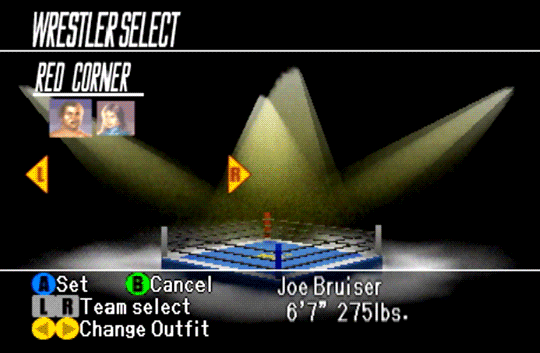
- Joe Bruiser (Muhammad Ali)
- Black Widow (Manami Toyota, the only female included)
Without really being into wrestling that much, my friends and I had fun coming up with our own backstories with the characters. Sting and “Sting” would be my constant tag-team go-to, despite the fact they were real life rivals on television. Dean Malenko and Rey Mysterio, Jr. had speed and unique moves that I found to be super appealing, regardless of the fact that I had never heard the word Cruiserweight before in my life. Glacier was also a favorite of mine due to his crazy, debilitating Cyronic Kick finisher. With him being a hidden character, I thought that he must be one of WCW’s strongest and best! His finisher would lay out EVERYONE, Glacier is probably the world champ!!
Imagine my surprise whenever I got around to seeing Glacier on television for the first time, and he was nothing more than Goldberg chum.
I was heartbroken.
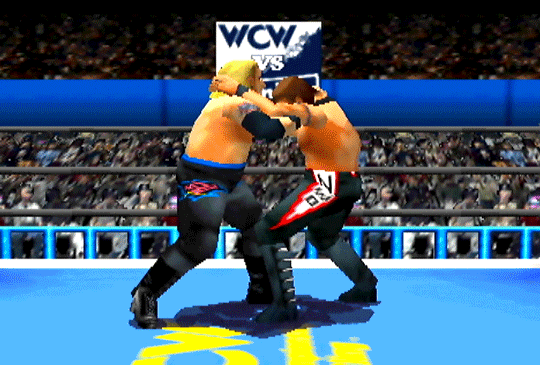
WCW vs nWo: World Tour ended up not only selling over a million copies but was the only wrestling game re-issued under the illustrious Player’s Choice banner. Asmik/AKI’s follow up WCW/nWo: Revenge would be released the next year and the improved wrestling mechanics would help the sequel sell more copies, but World Tour was the only one that had a second run in stores with a reduced price and Nintendo’s nifty, golden MILLION SELLER packaging.
It’s also worth nothing that less than a month after World Tour was released in America, Japan had their own version of the game which had more features than its US counterpart. Virtual Pro Wrestling 64 not only had most of the WCW and nWo wrestlers included (save for Glacier and Wrath), but a character edit mode was also included! This mode was similar to what Americans would get in Revenge as every wrestler had a limited amount of options based on their body size, but this gave you more creativity and choices when deciding upon each person’s allotted four outfit selections. Guys like Eddy Guerrero and Chris Benoit were even given their Japanese personas’ masks allowing you to wrestle as Black Tiger II and The Pegasus Kid.
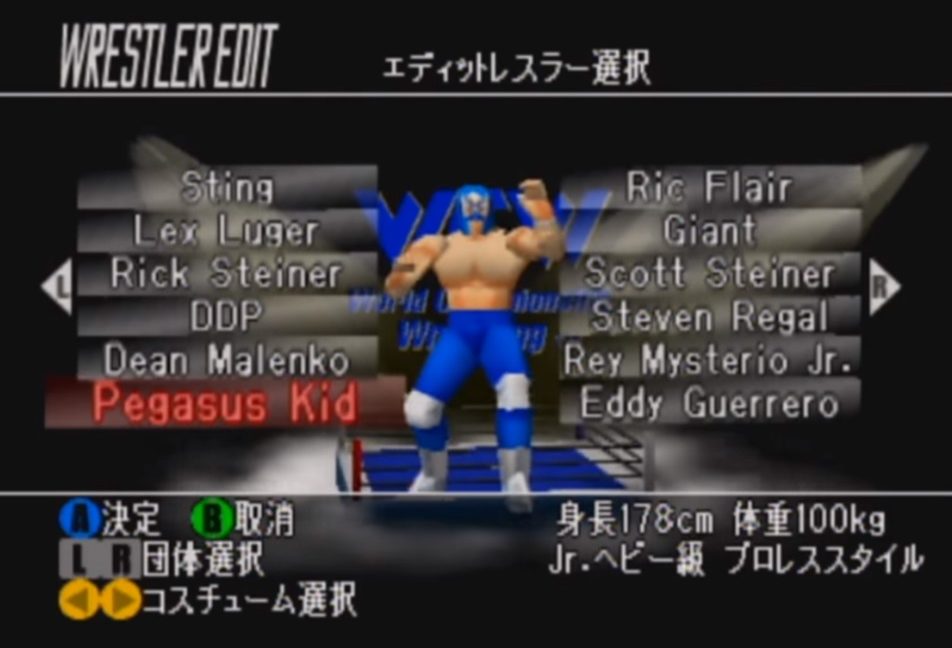
The roster for VPW 64 also had over one-hundred different legitimate wrestlers from various promotions. Notable Japanese legends like Jushin Liger, Keiji Mutoh (Great Muta), Tiger Mask and Giant Baba were available to select along with guys like Andre the Giant, The Road Warriors, Bam Bam Bigelow, Ken Shamrock, Mil Mascaras, and Terry Funk. A black/white filter could be placed over matches to give them a vintage feel and the fighting combo system from Revenge was also introduced here for the various MMA fighters you could play as. It boggles my mind how much better this version is compared to World Tour, but it wouldn’t be something I’d experience firsthand until buying it two years ago to play during WrestleThon. I was happy just being able to tear apart Rey Mysterio’s mask by grappling his face in the American game as a teenager. I had no idea I could be recreating the infamous Bruiser Brody vs Lex Luger match or even the brutal Vader vs Stan Hansen series on my Nintendo 64.
Ignorance is bliss, I guess.
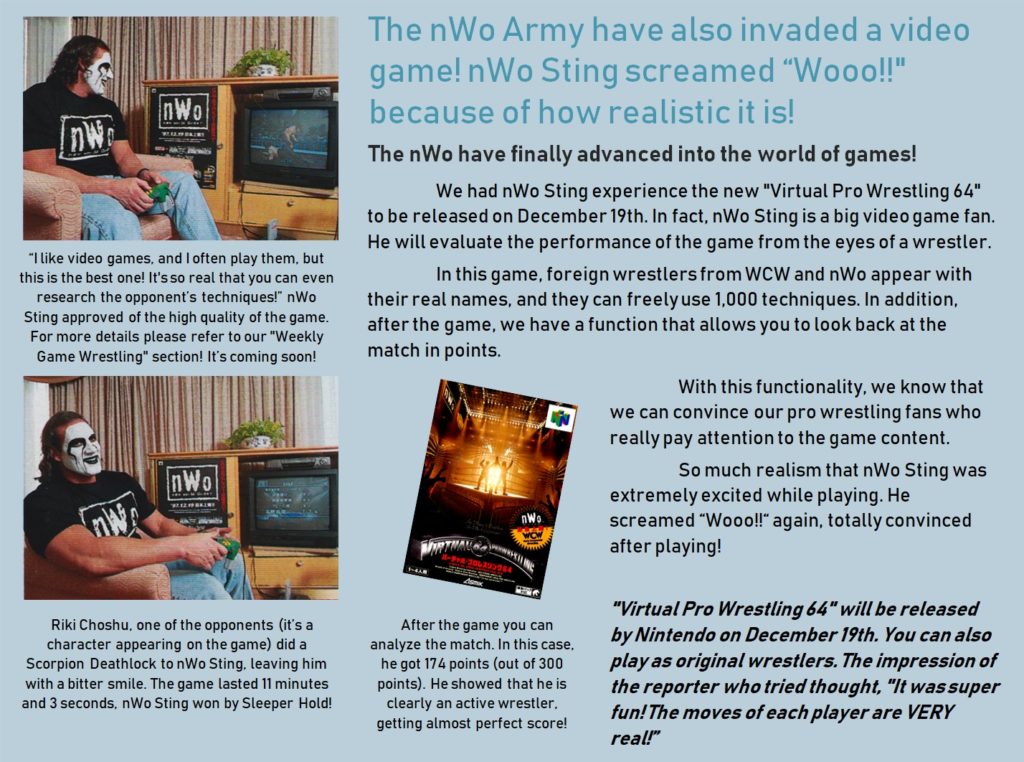
Twenty years later, WCW vs nWo: World Tour still stands up. Its hard for me to not become completely overtaken by nostalgia while talking about it, but I found more enjoyment revisiting it than playing through modern WWE games. I enjoy all of the dressing and presentation in WWE 2K18 a hell of a lot more, but the actual gamplay and matches themselves are much more entertaining to me in these N64 titles. It’s telling that other companies over the years have tried and failed to replicate the AKI wrestling system to various degrees. Shuji Yoshida and his team created something revolutionary for its time, and Asmik/AKI’s series of wrestling titles are still just as beloved today. Just asking Twitter for their memories of World Tour flooded my responses with various memories that all weren’t too different from my own.
At this point, Asmik Ace Entertainment, AKI Corporation and even THQ have moved on from wrestling games. Asmik is known for developing Japanese television and film, and AKI are now releasing Style Savvy titles for the Nintendo 3DS systems under their new name, Syn Sophia. THQ was gutted and sold for parts in 2012. Hell, World Championship Wrestling was bought out by the World Wrestling Federation in 2001! Let’s face it, you’ll most likely never be able to play a re-released HD version of World Tour on modern consoles ever in your life (my head hurts thinking about the copyright issues here).
The only way you can experience it yourself is the way we all did twenty-years-ago, with that…. odd… misshapen mess of a controller that’s super weird to go back and revisit nowadays in hand and the original cart plugged in to an N64.
Or an emulator would work too, but where’s the legitimacy in doing that??

40-year-old World Championship Wrestling fanatic/collector/hoarder. Safety officer by day, scanner of wrestling magazine by night.
He’s got posters on the wall, his favorite rock group’s KISS.
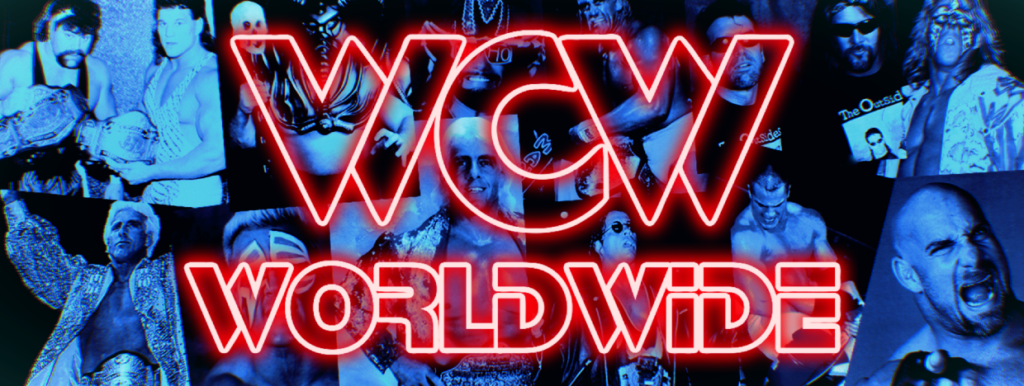
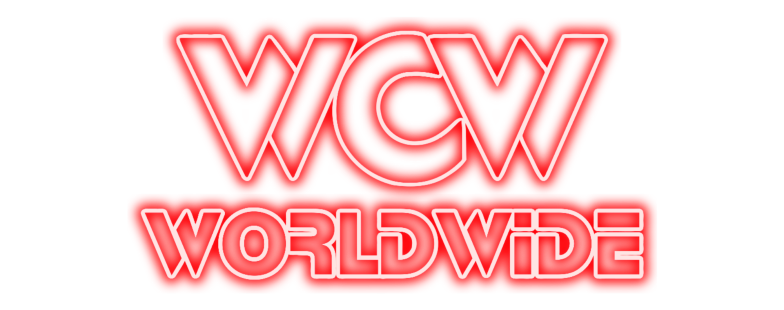
![WCW eBay Find of the Day: JCP + NWA Danger Zone Calendar [1988]](https://wcwworldwide.com/wp-content/uploads/2023/08/dangerzone-banner-218x150.jpg)
![WCW eBay Find of the Day: NWA/WCW ROOS Shoes Catalog [1990]](https://wcwworldwide.com/wp-content/uploads/2023/01/Roos-wcw-banner-02-218x150.jpg)
![Full Magazine Scans: WCW Wrestling Wrap-Up [March 1990]](https://wcwworldwide.com/wp-content/uploads/2020/09/LexLugerBanner-218x150.png)
![Full Magazine Scans: NWA Wrestling Wrap-Up [May 1989]](https://wcwworldwide.com/wp-content/uploads/2020/07/eddie-missy-rick-banner-218x150.png)
![Full Magazine Scans: NWA Wrestling Wrap-Up [February 1990]](https://wcwworldwide.com/wp-content/uploads/2020/04/ZManBanner-218x150.png)
![Full Magazine Scans: WCW Magazine (Germany) [November 1994]](https://wcwworldwide.com/wp-content/uploads/2021/05/jeanpaul-banner-218x150.png)
![Full Magazine Scans: WCW Magazine [February 1994]](https://wcwworldwide.com/wp-content/uploads/2021/05/maxxpayne-banner-218x150.png)
![Full Magazine Scans: NJPW Magazine Special #82 [1992]](https://wcwworldwide.com/wp-content/uploads/2020/09/steinersbanner-218x150.png)
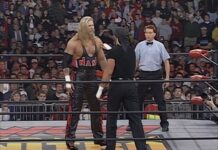
![Full Magazine Scans: WCW Magazine #55 [November 1999]](https://wcwworldwide.com/wp-content/uploads/2023/07/bret-hart-banner-218x150.jpg)
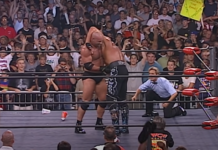

![Full Magazine Scans: WCW Magazine #51 [June 1999]](https://wcwworldwide.com/wp-content/uploads/2023/02/Macho-Banner1-218x150.jpg)
![Complete Collection of Valentine’s Day WCW/nWo Cards! [1998-2000]](https://wcwworldwide.com/wp-content/uploads/2021/02/ValentinesBanner-218x150.jpg)
![This Day in WCW History: WCW Signs Off Forever [2001]](https://wcwworldwide.com/wp-content/uploads/2019/03/wcwworldwidebanner02-218x150.png)
![Full Magazine Scans: DK Readers’ WCW Fit for the Title [2001]](https://wcwworldwide.com/wp-content/uploads/2018/10/Kidman-218x150.png)
![Full Magazine Scans: WCW Magazine #58 [February 2000]](https://wcwworldwide.com/wp-content/uploads/2018/09/VampImage-218x150.png)
![Full Magazine Scans: WCW Australia Tour Program [2000]](https://wcwworldwide.com/wp-content/uploads/2018/09/WCWTourBannerLogo-218x150.png)

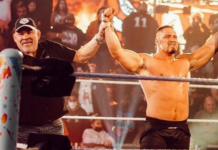
![This Day in WCW History: The Final Episode of ‘WCW Monday Nitro’ Airs [2001]](https://wcwworldwide.com/wp-content/uploads/2017/03/McMahonIsSatanCover-218x150.jpg)
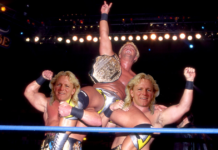
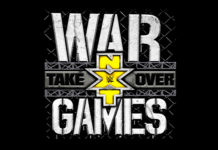

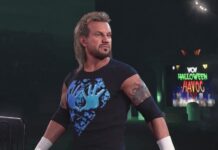
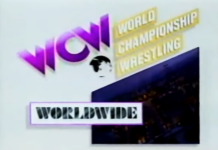
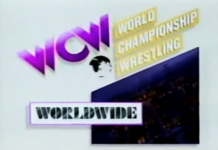
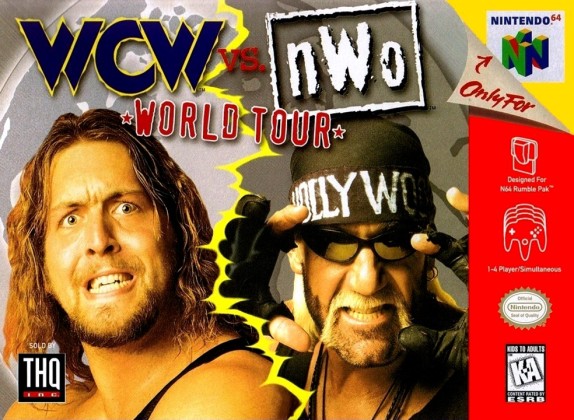
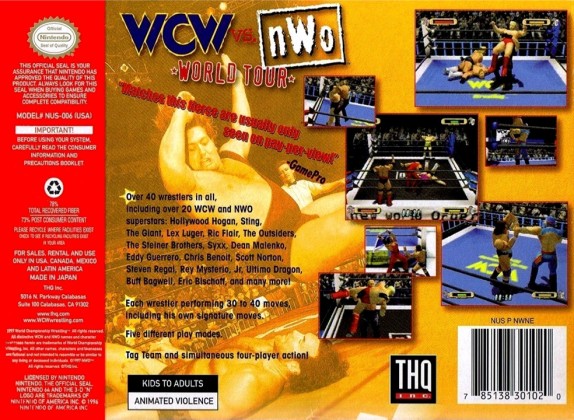
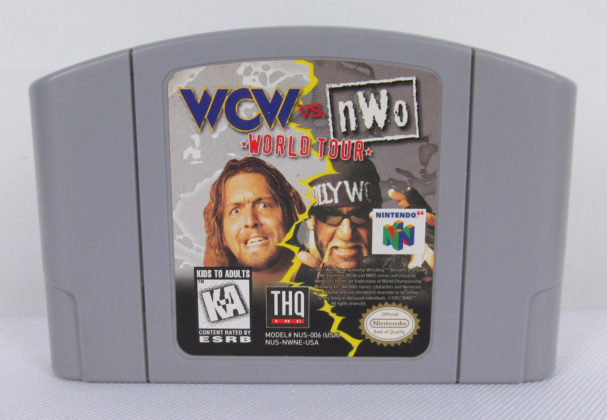
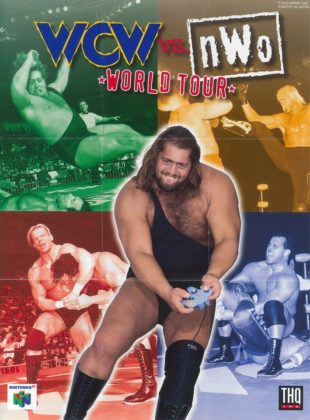
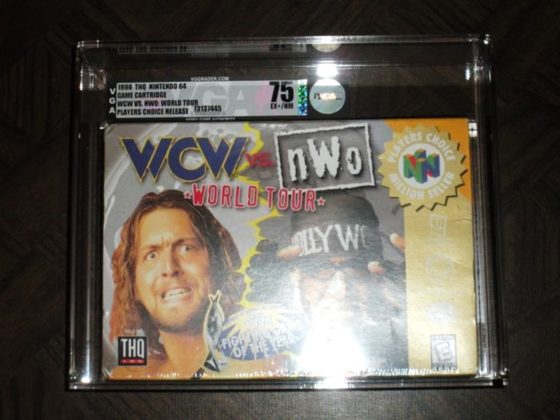
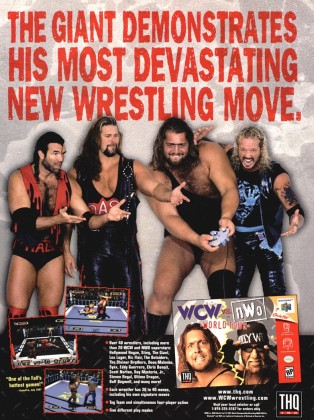
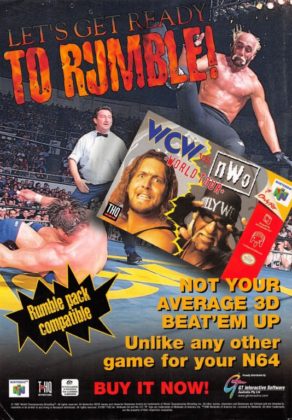
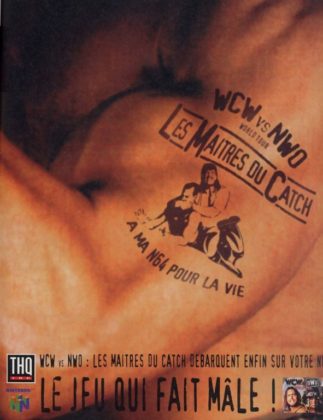
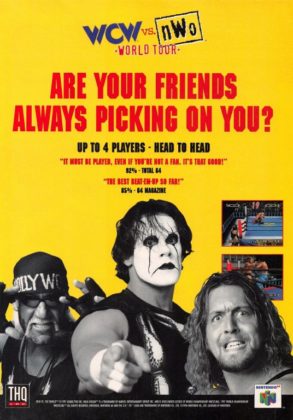
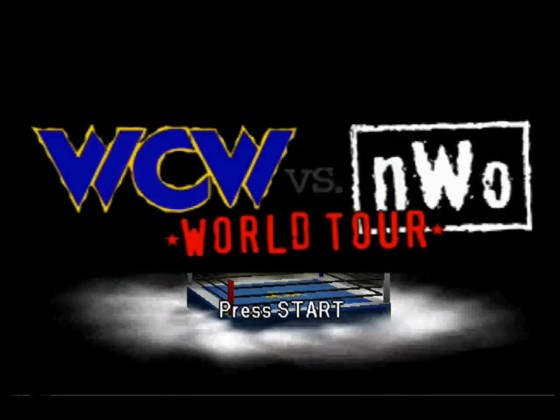
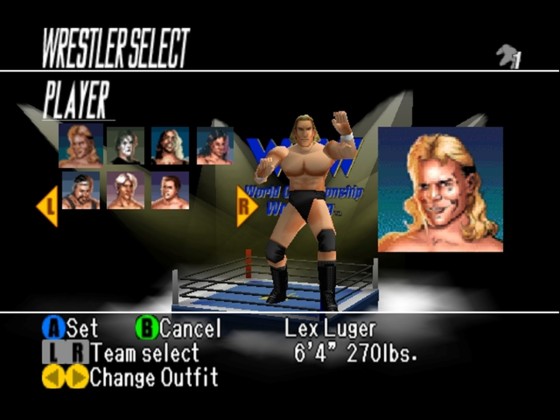
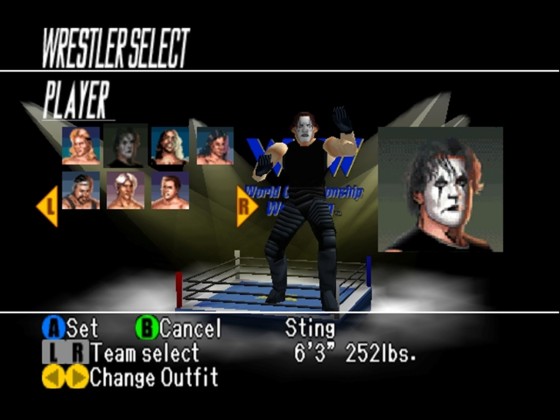
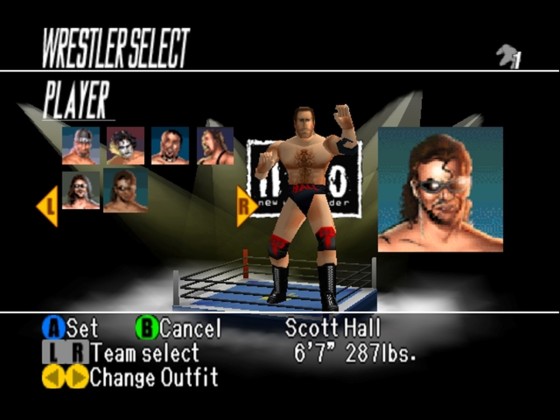
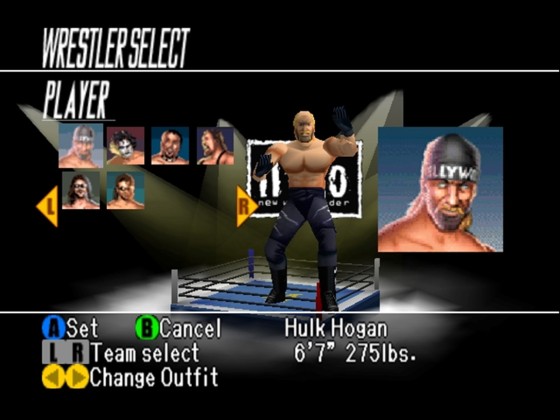
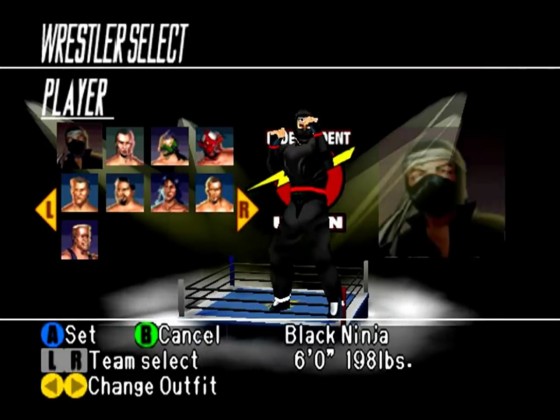
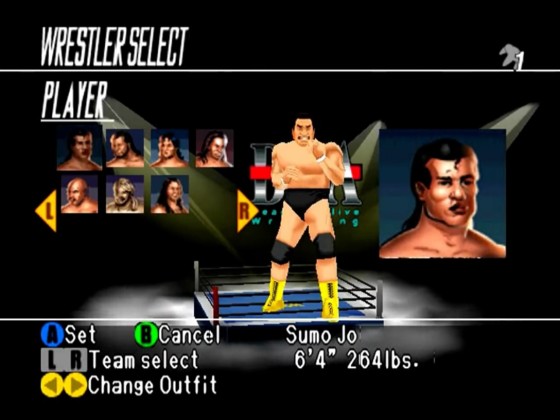
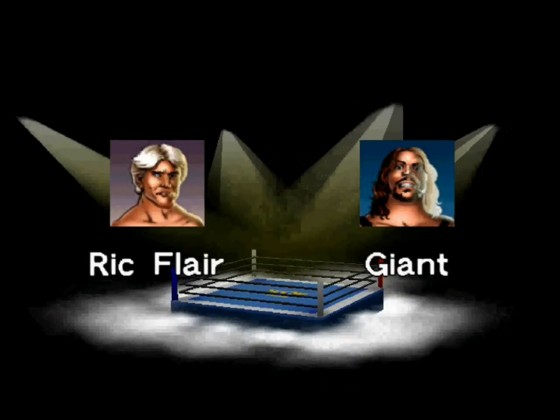
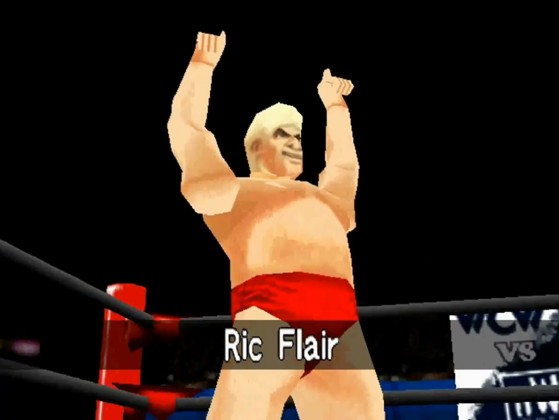
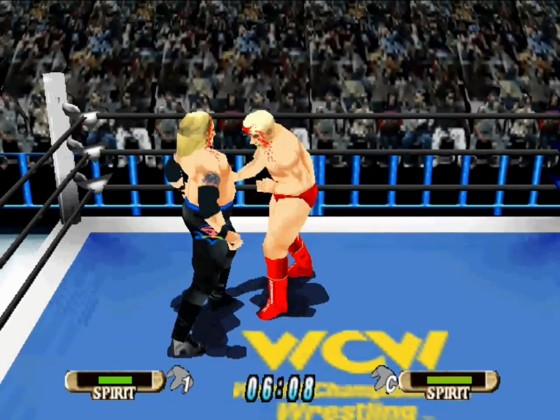
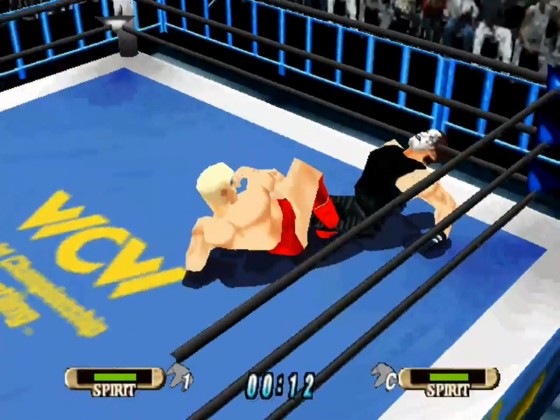
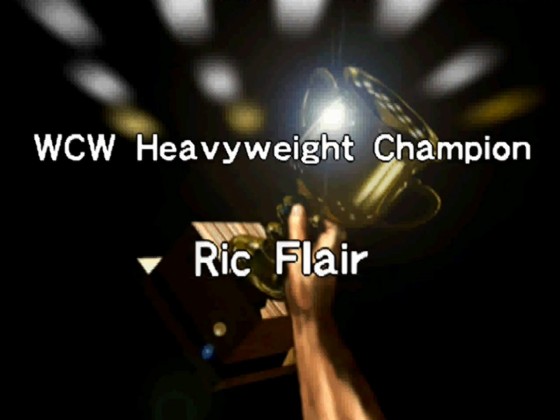
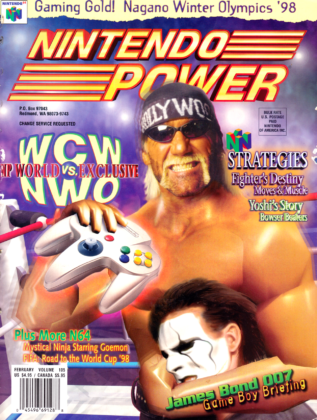
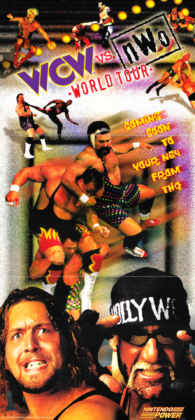
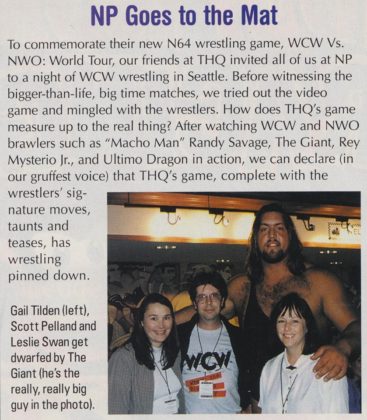
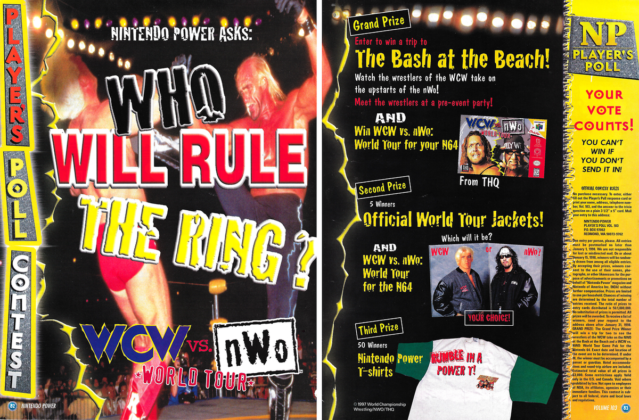
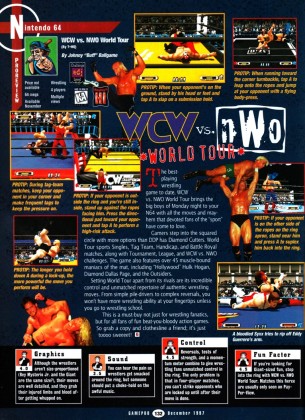
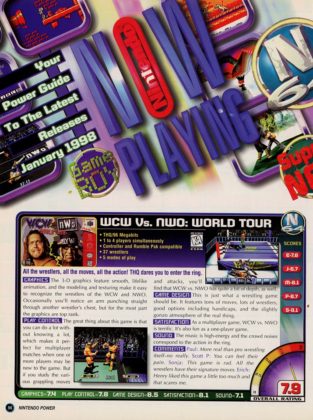
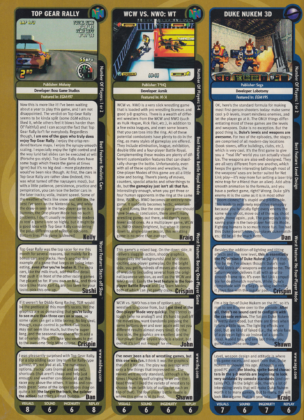
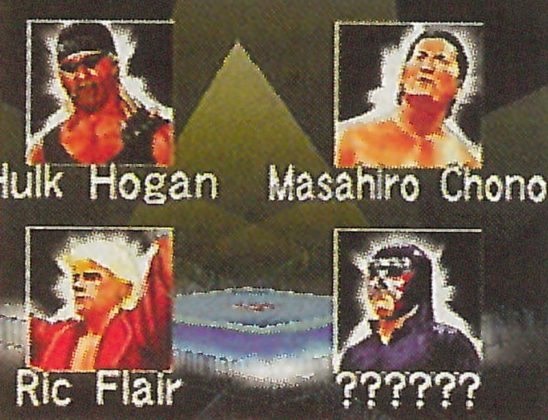
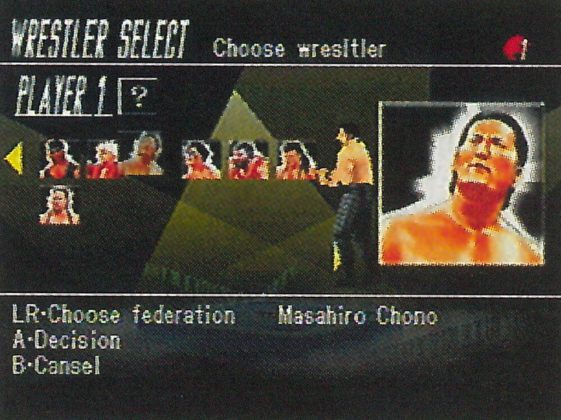
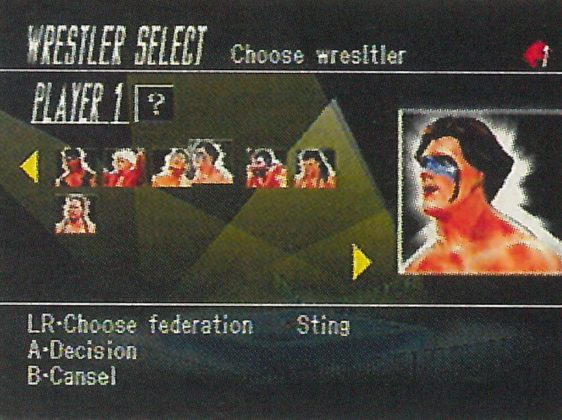
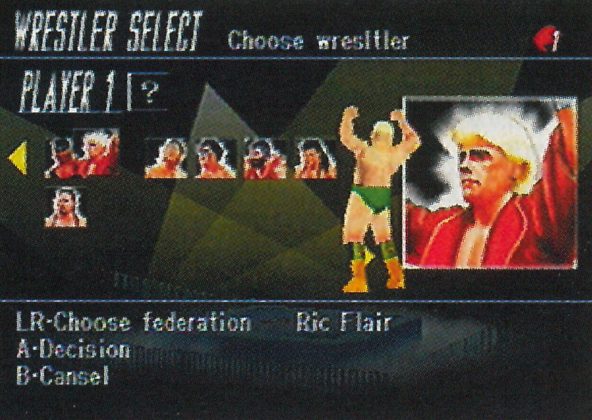
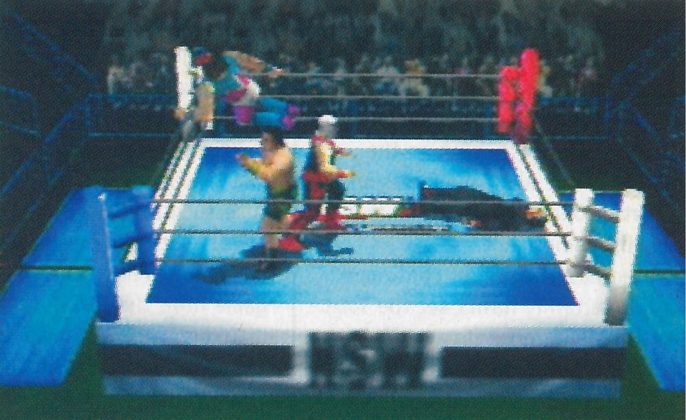
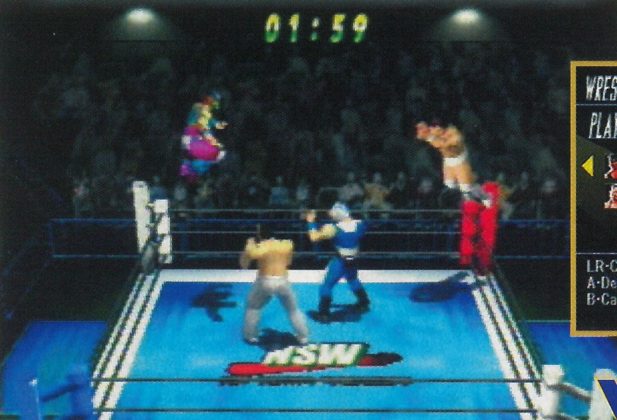
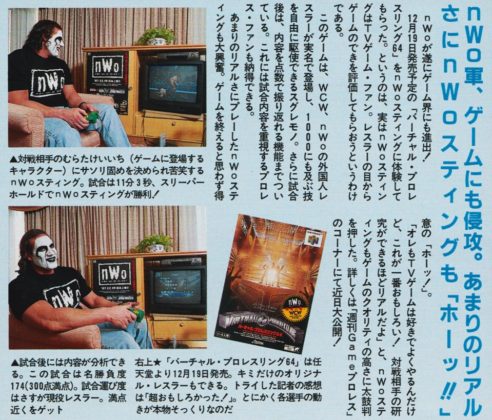
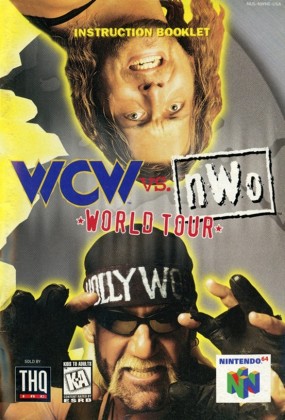
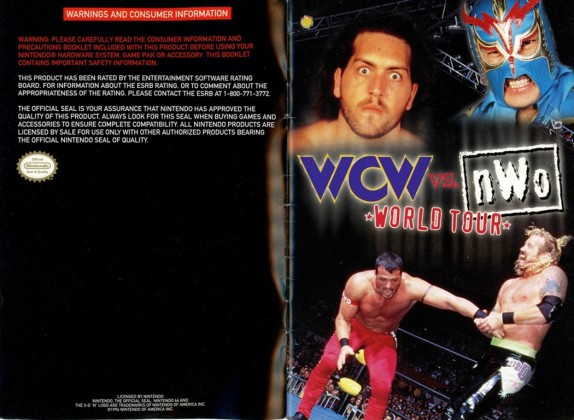
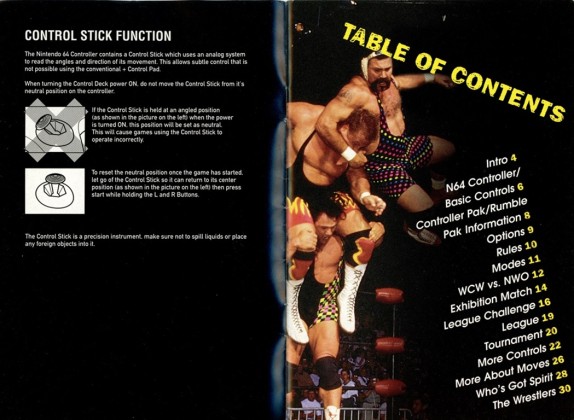
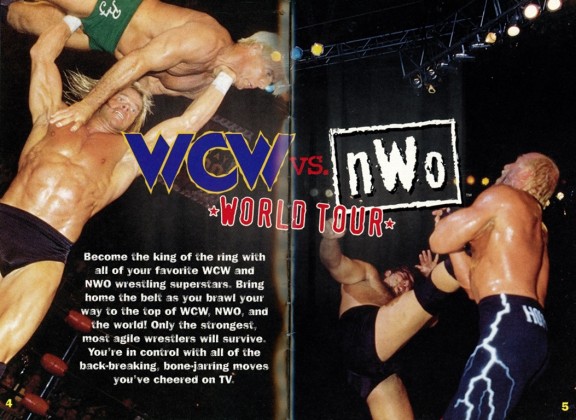
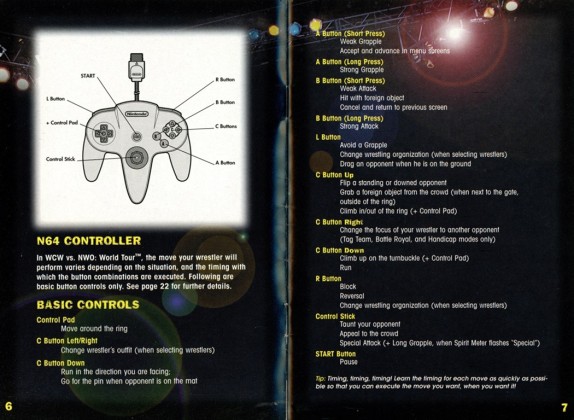
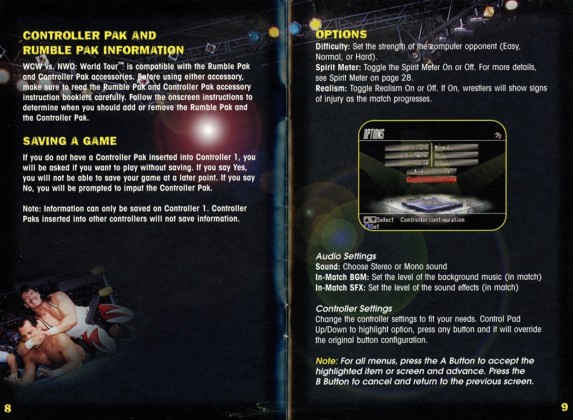
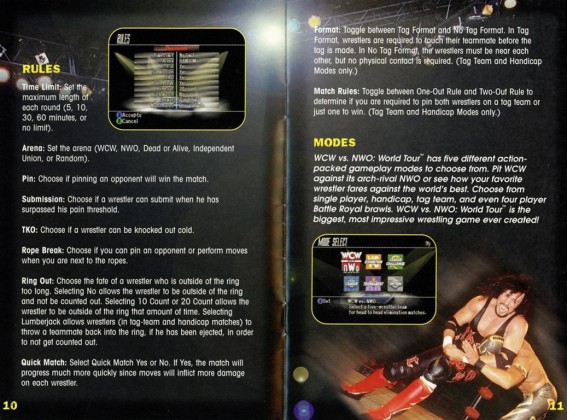
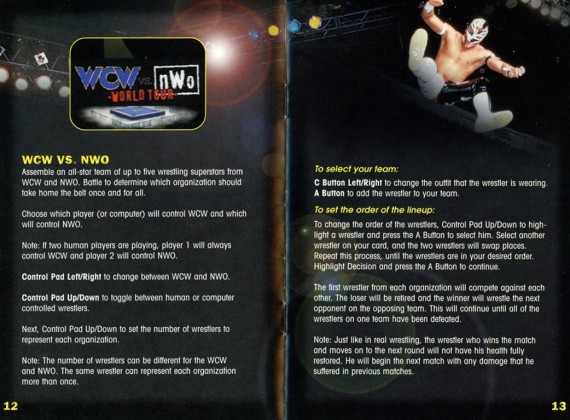
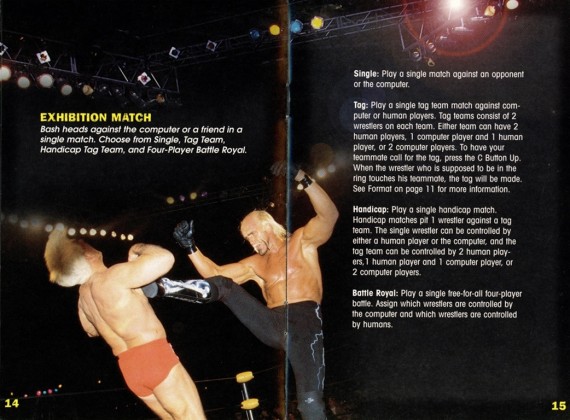
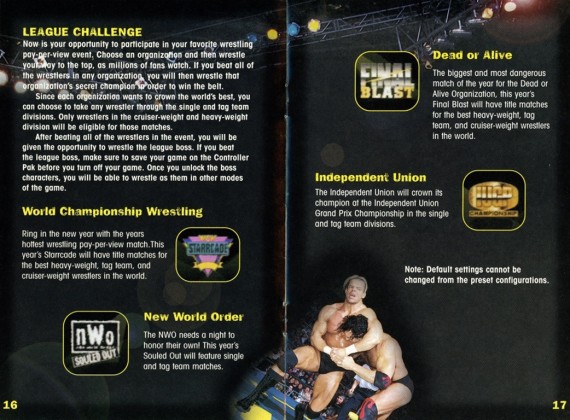
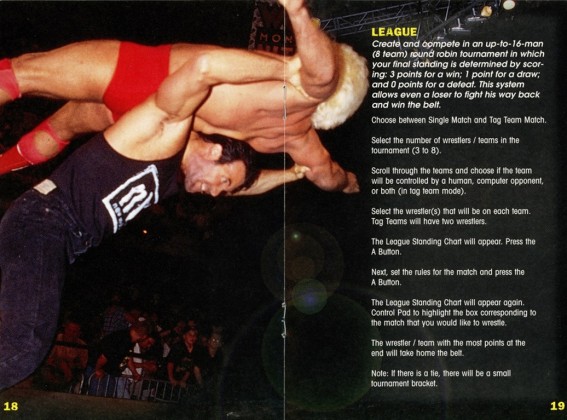
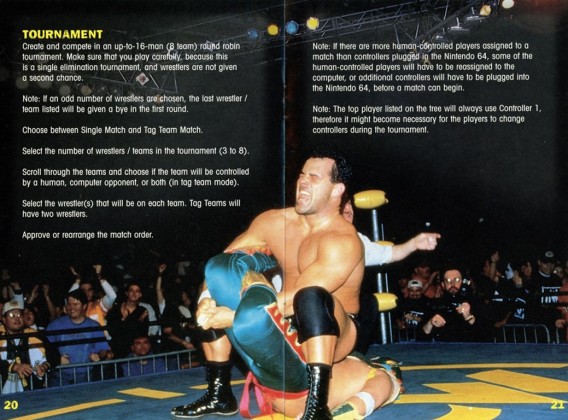
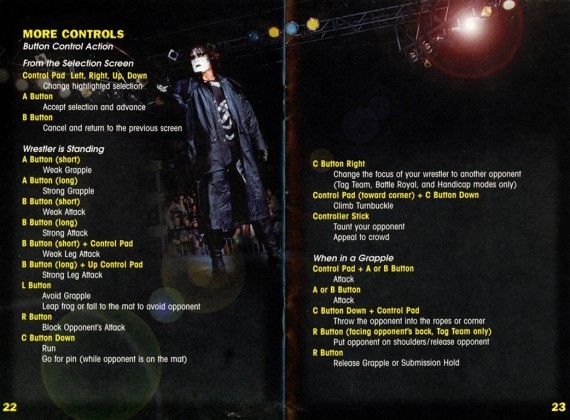
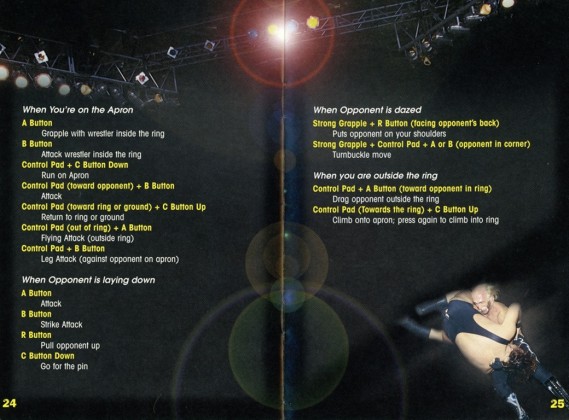
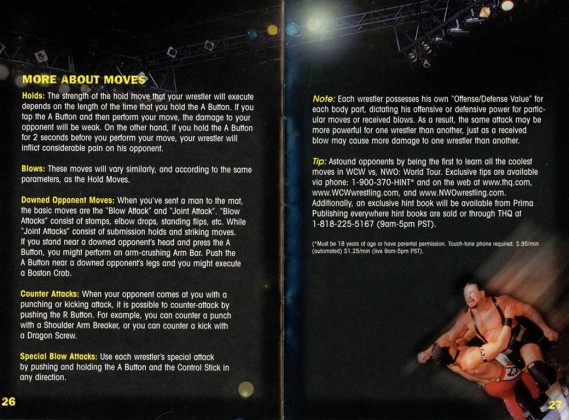
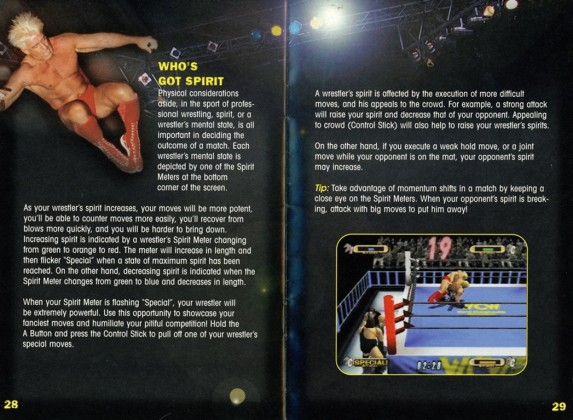
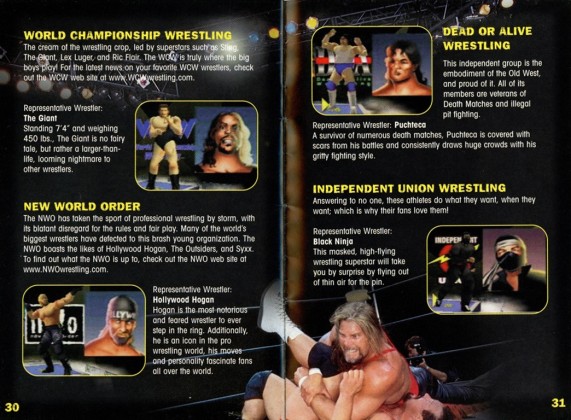
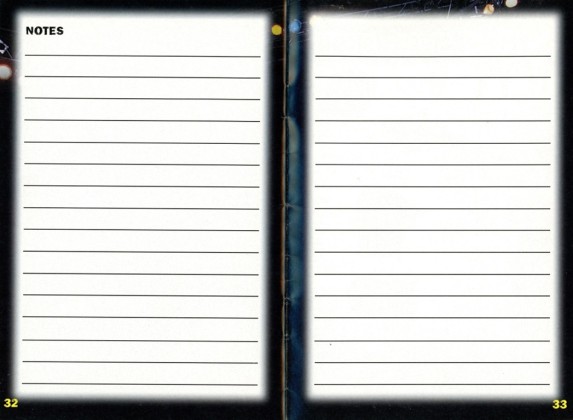
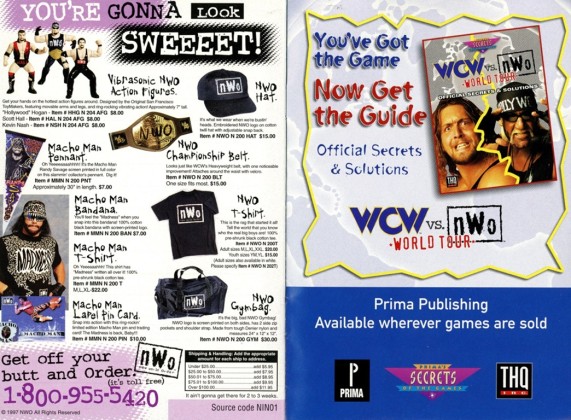
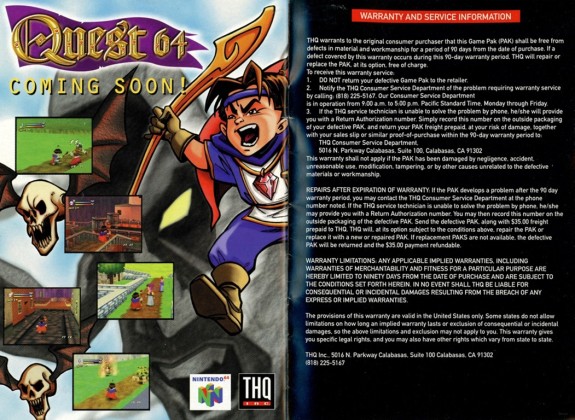
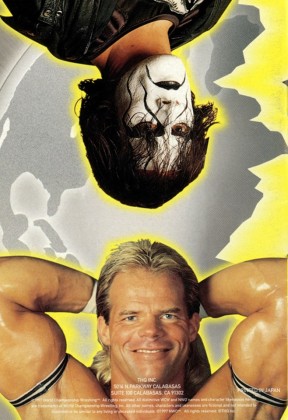
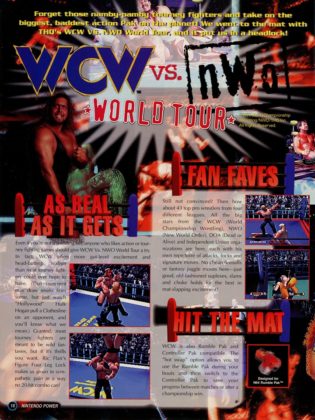
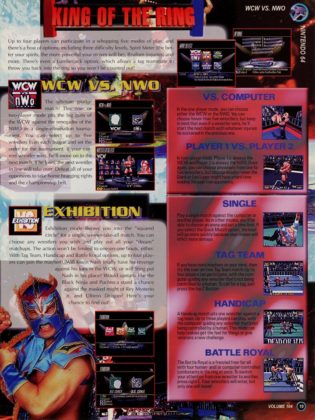
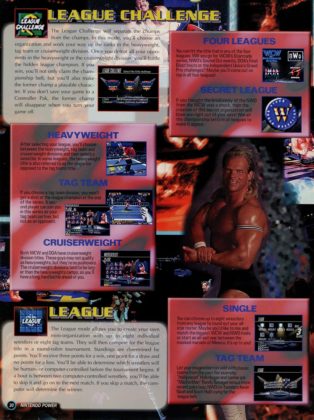
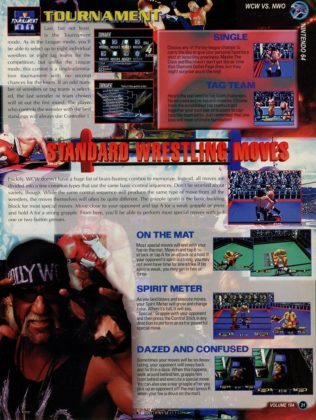
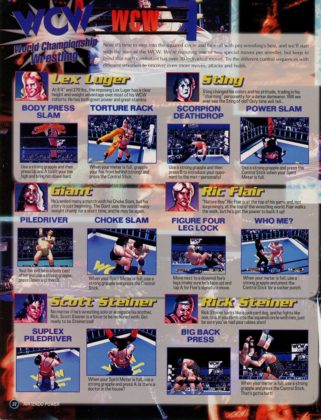
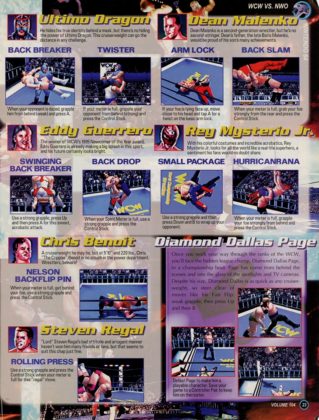
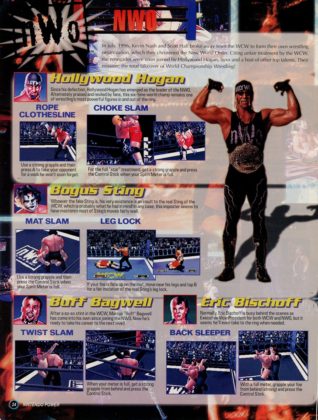
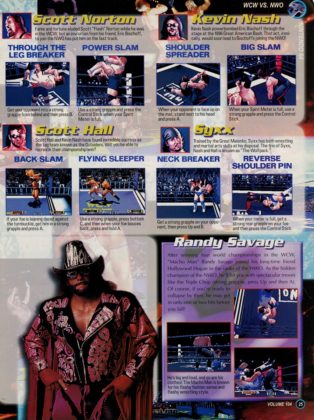
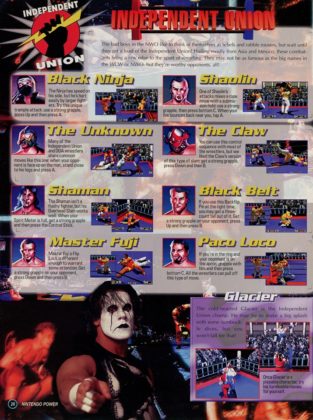
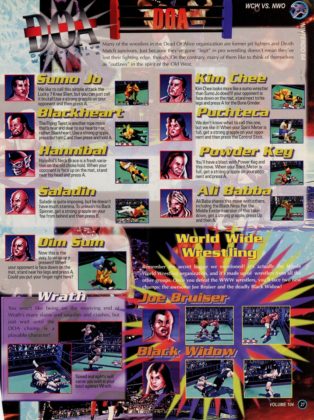
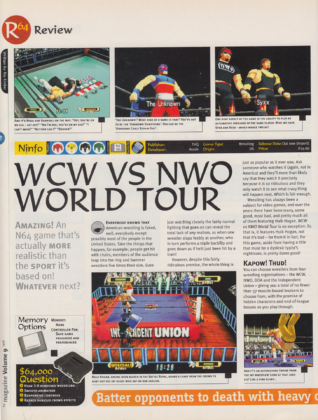
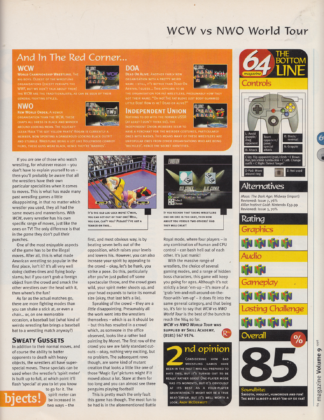
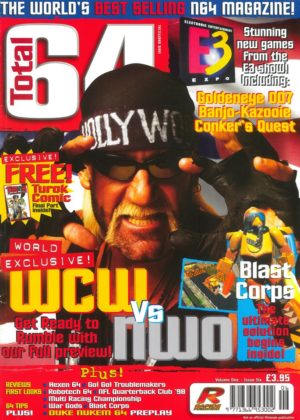
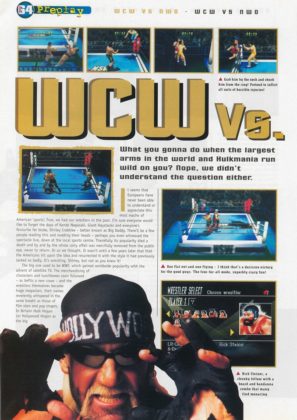
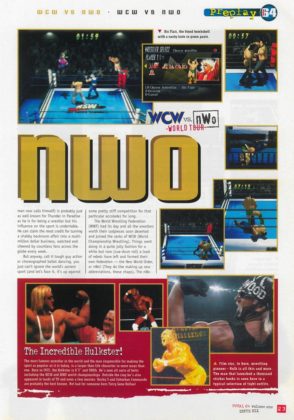
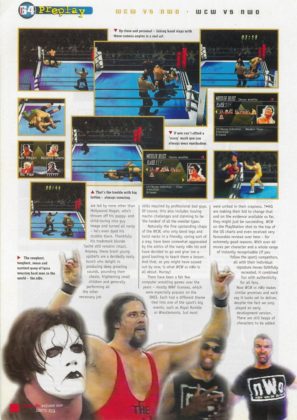
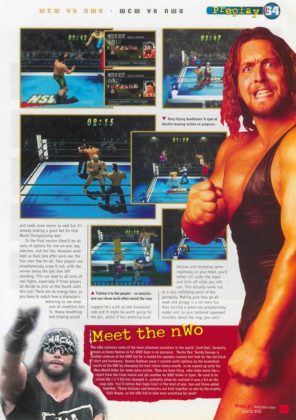
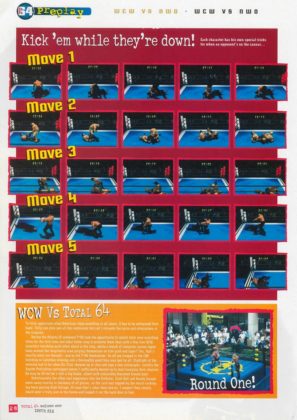
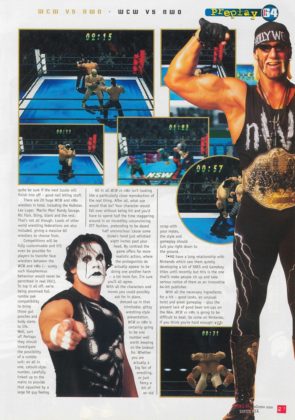
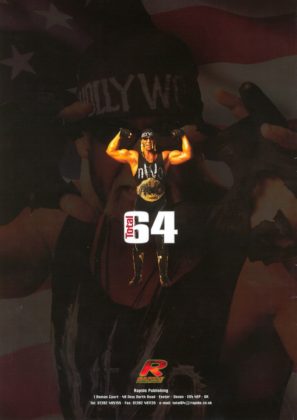
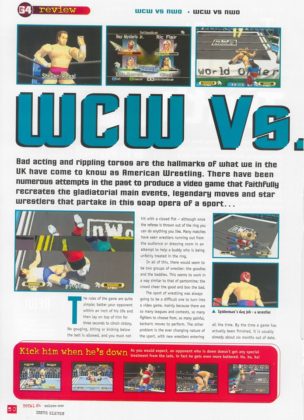
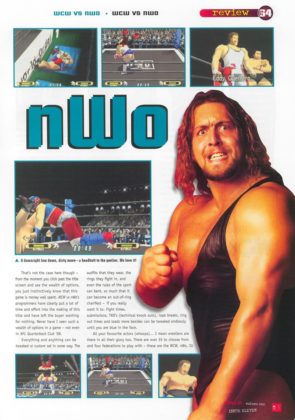

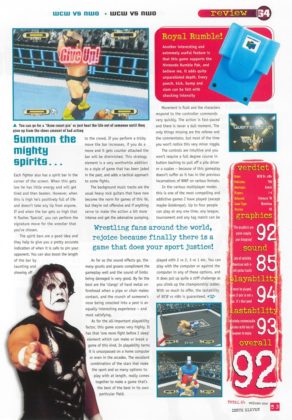
Unlocking what was essentially Muhammad Ali (Joe Bruiser) and KOing opponents in sometimes under 30 seconds.
He was so fun to play as
The reason i got an n64 for xmas 97 instead of a ps1
Revenge was better
I got World Tour after I had Revenge just so I could have both of the WCW games (at the time) on N64.
This game showed me how good wrestling games could be.
I got this after WWF Warzone and all of a sudden I wanted to play Wrestling games again.
Perfection!
I always used the kick out cheat in multiplayer
Heh.
I had wcw nwo revenge. Loved that game!
What a game. I still like it over no mercy because of the roster
My brothers and I had every wcw and wwf N64 games and with all the wwf custom making we made all the wcw stars.
I am 34 and still rave about how good these wrestling games were
Same for me. Timeless game.
I had many fun hours playing this!
Still have it awesome game
I would like to see how this looks with those HDMI and graphics mods on the 64.
Great game by far. Loved the wrestler selection, the gameplay, and the gameplay. Many of THQs titles continued this format like WCW/NWO Revenge, WWF Wrestlemania 2000, And WWF No Mercy. WCW/NWO World Tour was a great stepping stone towards the greatest wrestling games ever made. Played it many times with friends but when I finally got an N64 myself I got Revenge first the year it came out. I went to the local rental place the following year and seen n64 games for sale and World Tour was there for I believe $10 used so I bought it finally.
This is the game that truly got me into wrestling
Daniel Bonner
Favorite wrestling game
It took what WCW vs The World started, and kicked it up to a whole new level.
My favourite wrestling game. Great roster, decent amount of features and game modes and that engine was just fantastic!
I realised just how much I love this game when, playing as sting, I’d been facing Flair for around 15 minutes of back and forth action, near falls and drama. I was on the ring apron and a bloodied flair approached me. I quickly grappled him, slamming his head in to the turnbuckle pad. As flair stumbled backwards I hopped to the top rope and dove off, taking him down with a flying clothesline. I took my chance and hurried for the pin. 1.. 2.. 3! The end to a classic encounter!
Liked it but WCW/nWo Revenge remains my favorite!
Kevin Curran
Hours of fun on this game, such great gameplay i cant understand why the new games cant do it as good.
“It not only was the first WCW title for a Nintendo system since 1994’s release of WCW: The Main Event for the Game Boy” – Wrong. A little bit of research would’ve shown that WCW: The Main Event was released in February 1994 while WCW SuperBrawl Wrestling for the SNES was released in November 1994, making it the last WCW Game on a Nintendo console (and the last WCW game until WCW vs. the World)
“In a way, maybe WCW vs nWo: World Tour could have been a factor in WCW and the WWF becoming pop-culture behemoths during the late 90’s.” – Doubtful. For one: Wrestling Games always were an afterthought with a negative reputation. Second: Nobody becomes a wrestling fan because he played a game, the games are usually only bought by fans. Third. The N64 was a massive failure. If anything the Playstation and its wrestling games had an impact but even that is doubtful. After all, WCW exploded when they didn’t give a shit about merchandise including video games.
You’re right. I had my dates wrong when it came to the SNES and Game Boy releases, so thank you for that. I corrected the post.
Everything else you’ve written though…. *shrug*
You sound like a fun guy.
Ali Baba was actually based on Tiger Jeet Singh